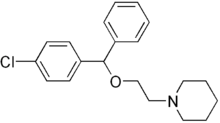Cloperastine
Cloperastine (INN) or cloperastin, also known as cloperastine hydrochloride (JAN) (brand names Hustazol, Nitossil, Seki) and cloperastine fendizoate (or hybenzoate), is an antitussive and antihistamine that is marketed as a cough suppressant in Japan, Hong Kong, and in some European countries.[1][2][3] It was first introduced in 1972 in Japan, and then in Italy in 1981.[4] The precise mechanism of action of cloperastine is not fully clear, but several different biological activities have been identified for the drug, of which include: ligand of the σ1 receptor (Ki = 20 nM) (likely an agonist),[5] GIRK channel blocker (described as "potent"),[6][7][8][9] antihistamine (Ki = 3.8 nM for the H1 receptor),[3][5] and anticholinergic.[3][10] It is thought that the latter two properties contribute to side effects, such as sedation and somnolence, while the former two may be involved in or responsible for the antitussive efficacy of cloperastine.[5][6]
 | |
| Clinical data | |
|---|---|
| Other names | HT-11 |
| AHFS/Drugs.com | International Drug Names |
| Routes of administration | Oral |
| ATC code | |
| Identifiers | |
IUPAC name
| |
| CAS Number | |
| PubChem CID | |
| DrugBank | |
| ChemSpider | |
| UNII | |
| KEGG | |
| ChEMBL | |
| CompTox Dashboard (EPA) | |
| ECHA InfoCard | 100.020.948 |
| Chemical and physical data | |
| Formula | C20H24ClNO |
| Molar mass | 329.863 g/mol g·mol−1 |
| 3D model (JSmol) | |
SMILES
| |
InChI
| |
| | |
See also
References
- J. Elks (14 November 2014). The Dictionary of Drugs: Chemical Data: Chemical Data, Structures and Bibliographies. Springer. pp. 301–. ISBN 978-1-4757-2085-3.
- Index Nominum 2000: International Drug Directory. Taylor & Francis. January 2000. pp. 261–. ISBN 978-3-88763-075-1.
- Cuzzocrea, Salvator; Catania, Maria (2011). "Pharmacological and clinical overview of cloperastine in treatment of cough". Therapeutics and Clinical Risk Management. 7: 83. doi:10.2147/TCRM.S16643. ISSN 1178-203X. PMC 3061847. PMID 21445282.
- William Andrew Publishing (22 October 2013). Pharmaceutical Manufacturing Encyclopedia. Elsevier. pp. 1103–. ISBN 978-0-8155-1856-3.
- Gregori-Puigjane, E.; Setola, V.; Hert, J.; Crews, B. A.; Irwin, J. J.; Lounkine, E.; Marnett, L.; Roth, B. L.; Shoichet, B. K. (2012). "Identifying mechanism-of-action targets for drugs and probes". Proceedings of the National Academy of Sciences. 109 (28): 11178–11183. doi:10.1073/pnas.1204524109. ISSN 0027-8424. PMC 3396511. PMID 22711801.
- K. Fan Chung; John Widdicombe (30 September 2008). Pharmacology and Therapeutics of Cough. Springer Science & Business Media. pp. 230–. ISBN 978-3-540-79842-2.
- Soeda, Fumio; Fujieda, Yoshiko; Kinoshita, Mizue; Shirasaki, Tetsuya; Takahama, Kazuo (2016). "Centrally acting non-narcotic antitussives prevent hyperactivity in mice: Involvement of GIRK channels". Pharmacology Biochemistry and Behavior. 144: 26–32. doi:10.1016/j.pbb.2016.02.006. ISSN 0091-3057.
- YAMAMOTO, Gen; SOEDA, Fumio; SHIRASAKI, Tetsuya; TAKAHAMA, Kazuo (2011). "Is the GIRK Channel a Possible Target in the Development of a Novel Therapeutic Drug of Urinary Disturbance?". Yakugaku Zasshi. 131 (4): 523–532. doi:10.1248/yakushi.131.523. ISSN 0031-6903.
- KAWAURA, Kazuaki; HONDA, Sokichi; SOEDA, Fumio; SHIRASAKI, Tetsuya; TAKAHAMA, Kazuo (2010). "A Novel Antidepressant-like Action of Drugs Possessing GIRK Channel Blocking Action in Rats". Yakugaku Zasshi. 130 (5): 699–705. doi:10.1248/yakushi.130.699. ISSN 0031-6903.
- Andrejus Korolkovas (16 August 1988). Essentials of Medicinal Chemistry. Wiley. ISBN 978-0-471-88356-2.